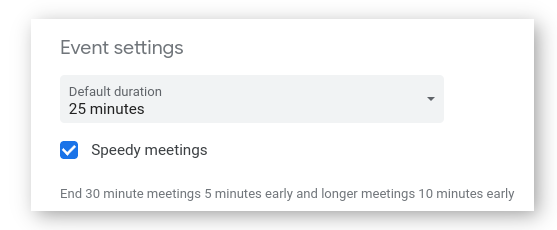Google introduced Speedy Meetings in 2011, which shortens meetings from 30 to 25 or 60 to 50 minutes. The intended goal was to allow you to “prep for your next meeting or get to your next appointment if you have a packed schedule.”

Sounds great, right? Unfortunately, speedy meetings the way Google has created them just don’t work. The temptation to keep the meeting going until :30 or :00 is just overwhelming. Human nature leads to people to keep talking past the supposed speedy meeting end time.
But there is a solution. Instead of ending meetings early, I’ve found it works much better to start meetings late! Wait wait, I know this sounds crazy, but hear me out.
Here’s how it works: turn on Google’s Speedy Meeting setting by clicking the gear menu at the top of Google Calendar and selecting Settings. Scroll down and click the Speedy Meetings checkbox.
Next comes the hard part: when you schedule a meeting, Google will default to having the meeting start at either :00 or :30, so you have to change the meeting to start at :05 or :35.
This is 2 extra clicks and 3 extra keystrokes, but it’s totally worth it.
People won’t end a meeting early, but they also won’t start a meeting early. So you can finally get those 5 minutes back. Use this time for clearing your head, checking email, bio breaks, preparing for your next meeting, or if you’ve RTO’d, walking between office conference rooms.
Note: Microsoft recently released the results of research they did on the importance of taking breaks between meetings. Their "research shows breaks are important, not just to make us less exhausted by the end of the day, but to actually improve our ability to focus and engage while in those meetings," says Michael Bohan, senior director of Microsoft’s Human Factors Engineering group, who oversaw the project.
Specifically, they found that:
- Breaks between meetings allow the brain to “reset,” reducing a cumulative buildup of stress across meetings.
- Back-to-back meetings can decrease your ability to focus and engage.
- Transitioning between meetings can be a source of high stress.
While there are lots of ways to reduce back-to-back meeting stress, starting your meetings 5 minutes later than normal is an easy and simple thing you can do right now.
Sometimes people won’t notice the :05 or :35 start time and will join the meeting on the hour or half-hour. But if they complain about having to wait 5 minutes, just remind them that they got some extra time to socialize and bond before the meeting starts. I think we can all use a little extra time to connect.
I started doing this during Covid so I had time to go check on the kids doing virtual school. But I found that it worked way better this way, so I kept it going after we returned to the office. And it’s starting to catch on at my workplace. People tell me they love having the 5 minutes between meetings.
Give it a shot yourself and let me know how it works out for you!
Update: I recently discovered that CapitalOne's Engineering department follows the :05 and :35 start time for meetings. This is great! If a huge organization like CapitalOne can adopt this, what's stopping you?